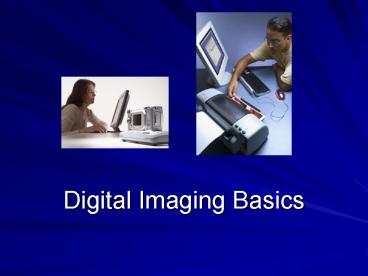Digital Imaging Basics - PowerPoint PPT Presentation
1 / 20
Title:
Digital Imaging Basics
Description:
Some digital video cameras can store images directly to a DVD, both standard size and mini DVD ... at a photo lab, submit them online, or print your own. ... – PowerPoint PPT presentation
Number of Views:44
Avg rating:3.0/5.0
Title: Digital Imaging Basics
1
Digital Imaging Basics
2
What is a digital image?
A digital image is a picture that is stored,
displayed, and/or manipulated using a computer or
some other electronic device
3
What is a digital image?
Electronic displays draw all images using three
basic colors red, green, and blue.
4
What is a digital image?
A digital image is actually computer code that
tells the display how to present the image. The
mixture levels of the three colors as well as the
level of brightness in the image are controlled
by the computer code and a variety of computer
parts (hardware).
5
What is a digital image?
Digital images are actually displayed with a
group of dots called pixels (short for picture
elements.)
6
Pixels
This image has 1024 pixels making it up (Its 32
dots by 32 dots or 32x32 pixels).
Here the same image has been expanded so that one
square in the image no longer represents one
pixel. Now each square is composed of multiple
pixels. This usually results in the stretched
out image looking blurry, a condition called
pixellated.
7
What are the different types of digital images?
rasterized (bitmap) Made of individual dots
(pixels). Bitmaps define a display space and the
color for each pixel or bit in the display
space. geometric (vector) represent the
picture using mathematical properties of
coordinates, length, or size
8
Image File Types
- JPG (jpeg or joint photographic experts group)
- the best file format to use when the picture is
one with lots of colors, shading, or gradients of
color. - support millions of colors and still manage to
keep the files relatively small - drawback for this type of file is its compression
method. It eliminates dots of color and
interpolates the in-betweens. Once compressed in
this fashion, the lost pixels are not recoverable.
9
Image File Types
- GIF (graphics interchange format)
- good choice when colors are limited to only a
- not good for photographs
- BMP (bitmap)
- very large files (take up lots of system
resources) - good choice for opening, editing, and re-editing
because the file retains all its details
10
Image File Types
- PNG (portable network graphics)
- often smaller file sizes than gifs
- completely patent and license free
- TIFF (tagged image file format)
- great to use if you want to maintain image
quality - good choice for use in desktop publishing, such
as newsletters, yearbooks, etc.
11
What devices are used to take pictures?
digital still cameras
12
Devices
digital video cameras
13
Devices
web cams
camera phones
14
How do I store my images?
Images are stored as computer code once they are
taken. A variety of media can be used for this
storage
Some cameras accept 3.5 inch floppy disks
15
Storage Media
Some cameras accept memory sticks, which can hold
varying amounts of data
16
Storage Media
Some digital video cameras can store images
directly to a DVD, both standard size and mini DVD
17
How do I get my pictures/video from my camera to
my computer?
disk memory card/stick readers USB (Universal
Serial Bus) cable Firewire (IEEE 1394) cable
18
What can I do with my images once I take and
store them?
Have them processed at a photo lab, submit them
online, or print your own.
Kodaks EasyShare system
19
Using Your Images
Place the images in an application like a word
processor, web page editor, or presentation
program.
20
Editing Images
Lots of software programs can be used to edit
digital images, and a lot of them are completely
free.
Advanced Editors Adobe Photoshop Macromedia
Fireworks JASC Paint Shop Pro
Basic Editors IrfanView (http//www.irfanview.com
) Microsofts PictureIt!































